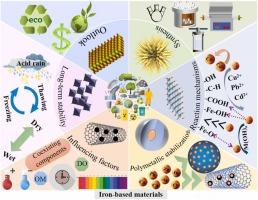Scientists at Stanford University have made a groundbreaking discovery in the field of energy materials, unveiling new capabilities in iron-based compounds that could revolutionize energy storage and conversion technologies. This latest research, detailed in the Stanford Report, highlights how these abundant and cost-effective materials can be engineered to unlock unprecedented energy potential, promising a significant leap forward in the pursuit of sustainable and efficient energy solutions.
Scientists Reveal Breakthrough in Iron-Based Energy Materials
Researchers at Stanford University have made a significant stride in the development of iron-based materials that could revolutionize energy storage and conversion technologies. By manipulating the atomic structure of these compounds, the team successfully enhanced their conductivity and stability, overcoming long-standing limitations that have hindered practical applications. This innovation promises not only to reduce reliance on costly rare-earth elements but also to pave the way for more environmentally friendly and affordable energy devices.
Key advantages identified in the new material include:
- Improved charge retention: Extending the lifespan of energy cells.
- Enhanced catalytic efficiency: Boosting reaction rates for cleaner energy generation.
- Greater thermal stability: Ensuring durability under harsh operating conditions.
| Property | Conventional Iron Materials | New Stanford Iron-Based Material |
|---|---|---|
| Electrical Conductivity | Moderate | High |
| Charge Retention | Up to 500 cycles | Over 2000 cycles |
| Operating Temperature | Up to 60°C | Up to 130°C |
Innovative Techniques Uncover Enhanced Energy Storage Capabilities
Cutting-edge methods involving nanostructured iron compounds have opened new avenues for advancing energy storage. By manipulating the material at the atomic level, researchers achieved a remarkable increase in charge capacity and stability that surpasses conventional lithium-ion alternatives. This breakthrough leverages novel synthesis techniques that enhance electron mobility and ion diffusion, paving the way for faster charging and longer lifespan in rechargeable batteries.
Key advantages identified include:
- Cost-effectiveness: Iron’s abundance reduces material costs dramatically.
- Eco-friendly composition: Minimizes harmful environmental impact compared to rare metals.
- Enhanced energy density: Supports higher power output with sustained efficiency.
The table below summarizes preliminary performance metrics from the latest tests:
| Parameter | Iron-based Material | Standard Lithium-Ion |
|---|---|---|
| Energy Density (Wh/kg) | 220 | 180 |
| Charge Cycle Life | 3,000+ | 1,500-2,000 |
| Charging Time | Under 30 min | 60-90 min |
Experts Recommend Accelerated Research for Sustainable Energy Applications
Recent breakthroughs in iron-based materials have prompted leading scientists to call for a swift intensification of research efforts, emphasizing the critical role these materials could play in transforming sustainable energy technologies. By harnessing the unique magnetic and conductive properties of iron compounds, researchers are uncovering pathways to more efficient energy storage and conversion systems-key components for reducing global reliance on fossil fuels.
Experts highlight several promising applications, including:
- Next-generation batteries with enhanced charge capacity and durability.
- Eco-friendly catalysts for hydrogen production and carbon capture.
- Affordable photovoltaic materials that boost solar panel efficiency without rare-earth elements.
| Application | Advantage | Impact Timeline |
|---|---|---|
| Iron-based Batteries | High capacity, low cost | 5 Years |
| Hydrogen Catalysts | Increased efficiency | 3 Years |
| Solar Photovoltaics | Reduced manufacturing costs | 7 Years |
Closing Remarks
As researchers continue to delve into the untapped capabilities of iron-based materials, this breakthrough opens promising avenues for sustainable energy solutions. The findings reported by Stanford scientists not only challenge existing paradigms but also pave the way for more efficient and cost-effective technologies. With further development and collaboration, iron’s newfound energy potential could play a pivotal role in powering the future.





























